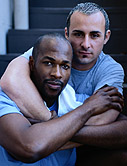
THURSDAY, Nov. 29 (HealthDay News) — The war against HIV/AIDS is far from over, U.S. health officials said on Thursday, with gay and bisexual men in urban centers accounting for most new infections in the United States.
Nearly 29,000 new cases of HIV, the AIDS-causing virus, were attributed to gay and bisexual males in 2010, and 82 percent of those cases occurred in large cities, the U.S. Centers for Disease Control and Prevention reported.
“The HIV epidemic in the United States highlights inequities,” said Dr. Jonathan Mermin, director of CDC’s Division of HIV/AIDS Prevention. “One is that gay and bisexual men are over 40 times more likely to have HIV than heterosexuals, and urban areas of the United States have higher HIV prevalence than rural areas.”
Another expert said the findings have real value in the fight against the virus.
“These findings allow us to focus prevention efforts,” noted Dr. Bruce Hirsch, an attending physician in infectious diseases at North Shore University Hospital in Manhasset, N.Y., who had no part in the study.
However, this is a challenging group to reach with education and prevention strategies, he said.
“There is a problem when you are young and healthy and have a lot of sexual desire — you feel indestructible,” Hirsch said.
In 2010, gay and bisexual males represented 62 percent of new HIV infections in large cities, 56 percent in smaller cities and 54 percent in non-urban areas, according to the study, published in the Nov. 30 issue of the CDC’s Morbidity and Mortality Weekly Report.
And nearly half of the new HIV infections reported among gay and bisexual men occurred in these seven cities: New York, Los Angeles, Miami, Atlanta, Chicago, Dallas and Houston.
In addition, four of the areas with the highest number of HIV infections among gay and bisexual men were in California: Los Angeles, Fresno, Modesto and Oxnard-Thousand Oaks-Ventura.
The U.S. National HIV Strategy has a goal of reducing HIV infections by 25 percent, the CDC’s Mermin said. “That is a challenging but achievable goal. We won’t reach it if we don’t decrease HIV infections among young and old gay and bisexual men.”
Disparities in HIV also exist in racial/ethnic groups, Mermin said. “We see marked racial disparities, 60 percent of youth with HIV infections were African American, 20 percent were Latino and 20 percent were white,” he said. “And black gay and bisexual men made up 54 percent of new HIV infections,” he added.
He said that what is needed is more education — especially education that targets groups such as blacks and Hispanics. Making testing more accessible and commonplace will also help, Mermin said, as would better access to treatment, especially for the poor.
Hirsch attributed some of this increase in HIV cases among gay and bisexual men to a reduced awareness of HIV. “It’s a time when the HIV epidemic is portrayed completely differently in the media compared to different eras,” he said. “There is a downplaying of the impact of the disease. I think HIV is being more understood as a chronic disease that is easily controlled.”
Although that’s largely true, prevention is vital, Hirsch said. “When the long-term risks of HIV are downplayed and when many people in the community are living long healthy lives with HIV, there is an underestimation of what it feels like to be HIV-positive,” he said.
People who are HIV-positive carry a psychological weight, in addition to the medical and financial burdens, Hirsch said. “In addition, taking medications on a day-in, day-out basis and having constant medical monitoring kind of reorganizes one’s life,” he said.
A positive health message about being HIV-free and healthy and active is essential to stem the problem, Hirsch said.
Hirsch advises young gay and bisexual men to take precautions to avoid HIV infection. “You’re too young and healthy to start a life confronting the real limitations and vulnerabilities of HIV,” he said. “Take care of yourself and have a safe and active love life.”
The study authors said programs that could reduce the number of HIV infections in cities include HIV testing, better care and treatment of those already infected, and risk counseling.
More information
For more information on HIV/AIDS, visit the U.S. Centers for Disease Control and Prevention.

